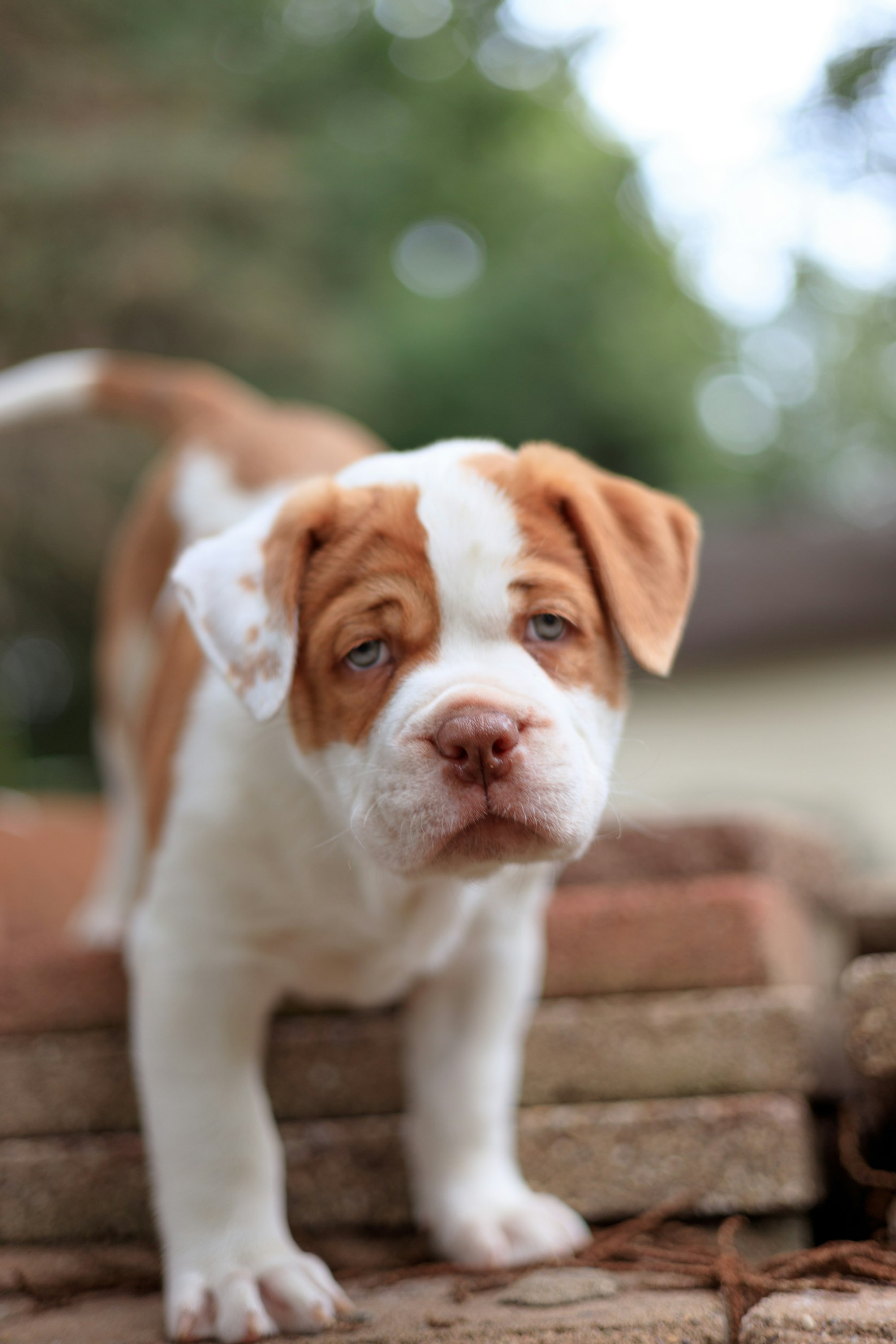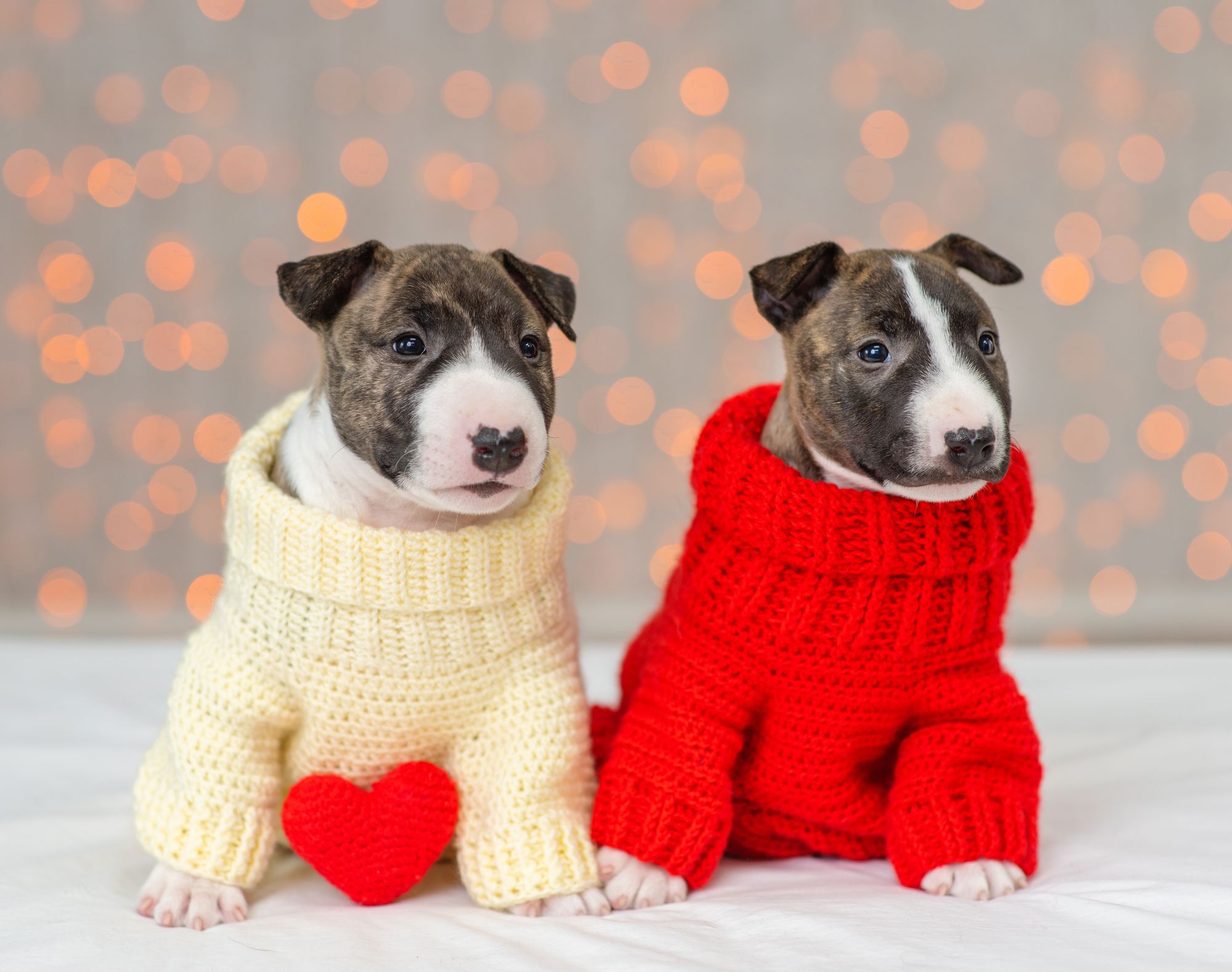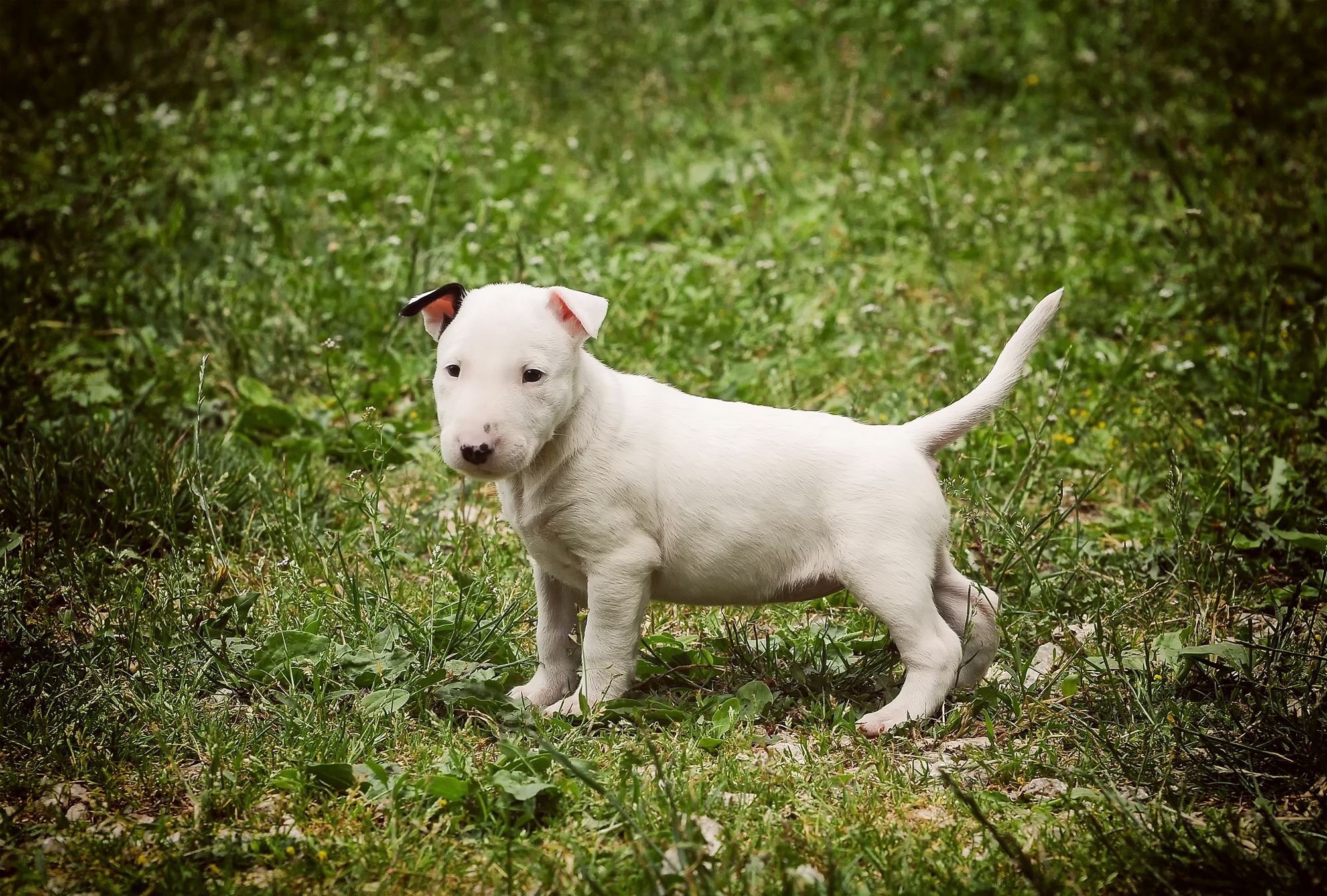Bringing a new furry friend into your life is an exciting journey, and if you're considering a Bull Terrier puppy, you're in for a delightful adventure. Bull Terrier puppies are known for their distinct appearance, boundless energy, and affectionate nature. In this guide, we'll cover everything you need to know about raising and caring for these playful companions.

Understanding Bull Terrier Breed
History and Origins
The Bull Terrier breed has a rich and intriguing history that traces back to 19th-century England. Originally developed for dogfighting, their ancestors were a cross between Bulldogs and various Terrier breeds. These early Bull Terriers possessed the strength and tenacity required for the brutal sport.
However, as attitudes towards animal cruelty evolved, the breed shifted its purpose. The aggressive traits were gradually bred out of them, leading to the creation of a more gentle and affectionate companion. This transition resulted in the Bull Terrier we know today, with a friendly demeanor and a strong bond with humans.
Physical Characteristics
Bull Terriers are instantly recognizable due to their distinct appearance. They boast an iconic egg-shaped head that's smooth and round, without any prominent eyebrows. Their muscular, compact body gives them a powerful stance, while their short, glossy coat comes in an array of colors, ranging from solid white to brindle.
One of the most distinctive features of Bull Terriers is their sharp, triangular eyes. These eyes radiate intelligence and curiosity, often capturing the attention of anyone they meet. Additionally, their small, upright ears enhance their alert and attentive expression.

Temperament Traits
Bull Terriers have a temperament that contradicts their historical roots. Despite their initial purpose as fighting dogs, they've evolved into affectionate and loving companions. They are highly social dogs that thrive on human interaction and attention.
These dogs are known for their playful and energetic nature. They enjoy engaging in activities and games that challenge them both mentally and physically. Their enthusiasm and spirited personality make them ideal for active families who can provide the stimulation they crave.
While Bull Terriers are loyal and affectionate towards their human family members, they may sometimes display a stubborn streak. This calls for patient and consistent training techniques that are based on positive reinforcement. Early socialization is essential to help them become well-adjusted and comfortable in various situations.
Preparing for Your Bull Terrier Puppy
Puppy-Proofing Your Home
Before bringing your miniature Bull Terrier puppy home, it's essential to create a safe environment by puppy-proofing your living space. Just like human toddlers, puppies are naturally curious and inclined to explore with their mouths. Here's how to make your home puppy-friendly:
- Remove Hazards: Identify and eliminate potential dangers such as electrical cords, small objects that could be swallowed, and toxic plants or substances. Puppies often chew on things they shouldn't so ensure these items are out of their reach.
- Secure Trash and Cleaning Supplies: Keep trash cans securely covered to prevent your puppy from rummaging through them. Store cleaning supplies and chemicals in cabinets that are inaccessible to your curious pup.
- Block Off Restricted Areas: Use baby gates or barriers to restrict access to rooms or areas that are off-limits. This will help you control where your puppy can roam and explore.
Necessary Supplies
Getting the right supplies is crucial to ensuring a smooth transition for your Bull Terrier puppy. Here's a list of essential items to have on hand:
- Comfortable Bed: Provide a cozy and comfortable bed where your puppy can rest.
- Food and Water Bowls: Opt for durable and easily washable bowls for feeding and hydration.
- Quality Puppy Food: Choose a high-quality puppy food that meets the nutritional needs of your growing Bull Terrier.
- Leash and Collar: Start leash training early with a well-fitting GPS dog collar and leash.
- Grooming Tools: Invest in brushes, combs, and nail clippers to keep your puppy's coat and nails in good condition.
- Interactive Toys: Provide interactive dog toys that engage your puppy's mind and body, helping them stay entertained and active.
- Training Treats: Use small, tasty treats for positive reinforcement during training sessions.

Setting up a Comfortable Space
Creating a designated space for your Bull Terrier puppy is essential for their comfort and well-being. Here's how to set up a cozy and welcoming area:
- Choose a Quiet Spot: Select a quiet corner of your home where your puppy can have some privacy. This will help them feel secure.
- Use a Crate or Bed: Provide a crate or a comfortable bed for your puppy to sleep and relax. A crate can also aid in housetraining.
- Create a Play Area: Set up an area with puppy-safe toys where your pup can play and expend their energy.
- Puppy-Proof the Space: Ensure the designated area is free of potential hazards and items your puppy could chew on.
By puppy-proofing your home, gathering the necessary supplies, and setting up a comfortable space, you're laying the foundation for a smooth transition for your Bull Terrier puppy. A safe and welcoming environment will help them adjust and thrive as they become an integral part of your family.
Feeding and Nutrition
Dietary Requirements
Providing the right nutrition is crucial for your Bull Terrier puppy's growth and overall health. Here's what you need to know about their dietary requirements:
- Balanced Diet: Your puppy needs a well-balanced diet that includes proteins, carbohydrates, fats, vitamins, and minerals. Look for high-quality puppy dog food that lists meat as the main ingredient.
- Protein: Protein is essential for muscle development. Choose a puppy food with a protein content appropriate for your puppy's age and size.
- Calcium and Phosphorus: These minerals are vital for bone and teeth development. Ensure your puppy's food contains appropriate levels of these nutrients.
- Avoid Overfeeding: Follow the feeding guidelines provided on the puppy food packaging to prevent overfeeding and weight-related issues.
Feeding Schedule
Establishing a consistent feeding schedule is important for your Bull Terrier puppy's digestion and housetraining. Here's a sample feeding schedule:
- Puppyhood: Puppies usually need to be fed three to four times a day. Divide their daily portion into multiple meals to accommodate their small stomachs.
- Transition to Adult Food: As your puppy grows, you can gradually transition to feeding them two meals a day, in the morning and evening.
- Portion Control: Consult your veterinarian to determine the appropriate portion size based on your puppy's age, weight, and activity level.
Treat Options
Treats are not only a great way to reward your Bull Terrier puppy during training, but they also provide an opportunity for bonding. Here's how to choose the right treats:
- Size Matters: Opt for small treats that your puppy can consume quickly. This prevents interruption in training sessions and avoids overfeeding.
- Healthy Ingredients: Choose treats made from high-quality ingredients. Look for options with real meat or natural ingredients.
- Training Treats: Reserve particularly tasty treats for training sessions. These special treats can motivate your puppy to learn new commands quickly.
- Calorie Consideration: Take treats into account when calculating your puppy's daily caloric intake. Adjust their regular meals if you've given them extra treats.
Remember, while treats are a valuable tool, they should make up only a small portion of your puppy's overall diet. Providing a balanced and nutritious diet is the key to supporting your Bull Terrier puppy's growth and well-being.

Training and Socialization
Basic Commands
Teaching your Bull Terrier puppy basic commands lays the foundation for effective communication and a well-behaved companion. Here are some essential commands to focus on:
- Sit: Teach your puppy to sit on command. Hold a treat above their head and slowly move it back. As their head follows the treat, their bottom will naturally lower into a sitting position.
- Stay: Train your puppy to stay in one place until you release them. Start by having them sit, then hold your hand out in a "stop" gesture while saying "stay." Gradually increase the time they stay before rewarding and releasing them.
- Come: Teaching your puppy to come when called is vital for safety. Use a happy and encouraging tone, and reward them with treats and praise when they respond.
Obedience Training
Consistent obedience training is essential for a well-mannered Bull Terrier puppy. Here's how to approach training:
- Positive Reinforcement: Use positive reinforcement techniques, such as treats, praise, and affection, to reward desired behaviors. This encourages your puppy to repeat those behaviors.
- Short Sessions: Keep training sessions short and engaging to prevent your puppy from losing interest. Aim for sessions that last around 10-15 minutes.
- Consistency: Be consistent with your commands and expectations. Use the same cues and rewards each time to avoid confusion.
- Patience: Remember that puppies take time to learn, so be patient and avoid getting frustrated. Celebrate small successes along the way.
Socializing with Other Pets
Proper socialization with other pets is vital to ensure your Bull Terrier puppy grows up to be a well-adjusted and friendly companion. Here's how to introduce them to other animals:
- Early Exposure: Start socializing your puppy with other pets at a young age. Gradually expose them to different animals in controlled and positive environments.
- Supervised Meetings: When introducing your puppy to other pets, keep them on a leash and closely supervise interactions. This prevents any potential misunderstandings or conflicts.
- Positive Associations: Reward your puppy for calm and appropriate behavior around other animals. Use treats and praise to reinforce positive interactions.
- Gradual Progression: As your puppy becomes more comfortable, gradually increase the complexity of interactions. This could include meeting pets of different sizes, ages, and temperaments.
By focusing on basic commands, consistent obedience training, and proper socialization with other pets, you're setting your Bull Terrier puppy up for a lifetime of positive interactions and good behavior. Building a strong foundation in these areas will enhance your bond and contribute to a harmonious relationship between your puppy and other animals.
Exercise and Playtime
Daily exercise needs
Bull Terrier puppies are known for their high energy levels and need for regular exercise. Meeting their daily exercise requirements is essential for their physical and mental well-being. Here's how to keep them active:

- Physical Activities: Engage your puppy in activities like brisk walks, jogging, or playing fetch. Aim for at least 30 to 60 minutes of exercise daily.
- Structured Play: Incorporate structured play sessions that involve running, jumping, and chasing toys. These activities help burn off excess energy and keep your puppy fit.
- Variety: Vary the types of exercises to prevent boredom. Consider outdoor games, hikes, and even friendly dog sports like agility or flyball.
Engaging Playtime Activities
Playtime is not only fun but also important for bonding and mental stimulation. Here are some engaging playtime activities for your Bull Terrier puppy:
- Interactive Toys: Use puzzle toys and treat-dispensing toys to challenge your puppy's problem-solving skills. These toys keep them mentally engaged as they figure out how to access treats.
- Hide and Seek: Hide treats or toys around the house and encourage your puppy to find them. This taps into their natural curiosity and scent-tracking abilities.
- Fetch: Playing fetch in the yard or a safe, open area helps your puppy burn energy and satisfies their desire to chase and retrieve.
- Tug-of-War: Tug-of-war games are not only physically engaging but also reinforce your bond with your puppy. Just ensure you use a sturdy toy and establish clear rules to prevent rough behavior.
Mental Stimulation
Mental stimulation is as important as physical exercise for Bull Terrier puppies. Keeping their minds active helps prevent boredom and promotes good behavior. Here's how to provide mental enrichment:
- Training Sessions: Continue practicing basic commands and introduce new ones. This challenges your puppy's cognitive abilities and strengthens your communication.
- Scent Work: Engage your puppy's sense of smell by hiding treats around the house or teaching them to follow scent trails.
- Problem-Solving Games: Use interactive games that require your puppy to figure out how to access rewards. This stimulates their problem-solving skills.
- Novel Experiences: Introduce your puppy to new environments, people, and objects. Novel experiences keep them curious and mentally engaged.
By addressing your Bull Terrier puppy's daily exercise needs, engaging them in playtime activities, and providing regular mental stimulation, you'll be ensuring their holistic well-being and promoting a happy and healthy life for your furry friend.
Grooming Tips
Maintaining your Bull Terrier puppy's grooming routine is essential for their health and appearance. Here are some grooming tips to keep in mind:
- Coat Care: Brush your puppy's short coat regularly to remove loose fur and distribute natural oils. This keeps their coat shiny and minimizes shedding.
- Bathing Guidelines: Bathe your puppy as needed, usually every 6-8 weeks or when they get dirty. Use a mild dog shampoo and ensure thorough rinsing.
- Nail Trimming: Regularly trim your puppy's nails to prevent overgrowth. Be cautious not to cut too close to the quick, which can cause bleeding and discomfort.
- Dental Care: Brush your puppy's teeth several times a week to prevent dental issues. Use a dog-specific toothbrush and toothpaste.
Healthcare and Vet Visits
Ensuring your Bull Terrier puppy's health requires regular vet visits and proper care. Here's what you need to know:
- Vaccination Schedule: Follow a vaccination schedule recommended by your vet to protect your puppy from common diseases.
- Parasite Prevention: Keep your puppy protected against fleas, ticks, and other parasites with appropriate preventive treatments.
- Regular Check-Ups: Schedule regular check-ups with your vet to monitor your puppy's overall health and catch any issues early.

Behavioral Challenges
Bull Terrier puppies, like any breed, might face behavioral challenges as they grow. Here's how to address common issues:
- Chewing Habits: Provide appropriate chew toys to redirect your puppy's chewing behavior away from furniture and belongings.
- Excessive Barking: Train your puppy to understand when barking is appropriate. Reward them for quiet behavior and address the root causes of excessive barking.
- Separation Anxiety: Gradually teach your puppy to be comfortable alone by leaving them for short periods and gradually increasing the time. Provide engaging toys to keep them occupied.
Traveling with Your Bull Terrier
Traveling with your Bull Terrier can be an enjoyable experience with proper planning:
- Car Safety: Use a well-fitted harness or dog seat belt to keep your puppy safe while traveling in the car.
- Travel Essentials: Pack essentials like food, water, bowls, a leash, waste bags, and your puppy's favorite toys when traveling.
- Accommodation Arrangements: Ensure your accommodation is pet-friendly and safe for your Bull Terrier.
Building a Strong Bond
Building a strong bond with your Bull Terrier puppy is vital for a harmonious relationship:
- Spending Quality Time: Dedicate time each day for bonding activities like cuddling, playing, and training.
- Positive Reinforcement: Use positive reinforcement techniques to foster trust and positive associations.
- Understanding Their Cues: Pay attention to your puppy's body language and preferences to strengthen your connection.

The Joy of Bull Terrier Ownership
Owning a Bull Terrier brings immeasurable joy and companionship:
- Unconditional Love: Bull Terriers are loyal and loving companions who form deep bonds with their owners.
- Shared Adventures: Enjoy outdoor activities, walks, and playtime with your puppy, creating lasting memories.
- Lifelong Memories: The unique personality and antics of your Bull Terrier will create cherished memories that last a lifetime.
Conclusion
Bringing a Bull Terrier puppy into your life can be an immensely rewarding experience. Their playful antics, boundless energy, and unwavering affection can make them wonderful companions for those willing to invest time and effort into their care and training. By understanding their history, physical traits, and unique needs, you'll be well-equipped to provide a loving and fulfilling life for your Bull Terrier puppy.
FAQs
Q1: How much exercise do Bull Terrier puppies need?
A: Bull Terrier puppies require around 30 to 60 minutes of exercise daily to keep them happy and healthy.
Q2: Are Bull Terriers good with children?
A: Yes, Bull Terriers can be great with children if properly socialized and trained. Always supervise interactions between dogs and kids.
Q3: Do Bull Terriers shed a lot?
A: Bull Terriers have a short coat that sheds moderately. Regular grooming can help manage shedding.
Q4: Can Bull Terriers live in apartments?
A: Yes, Bull Terriers can adapt to apartment living if provided with sufficient exercise and mental stimulation.
Q5: Are Bull Terriers prone to any health issues?
A: Bull Terriers can be prone to heart and kidney problems. Regular vet check-ups are essential to catch and manage any health concerns early.






